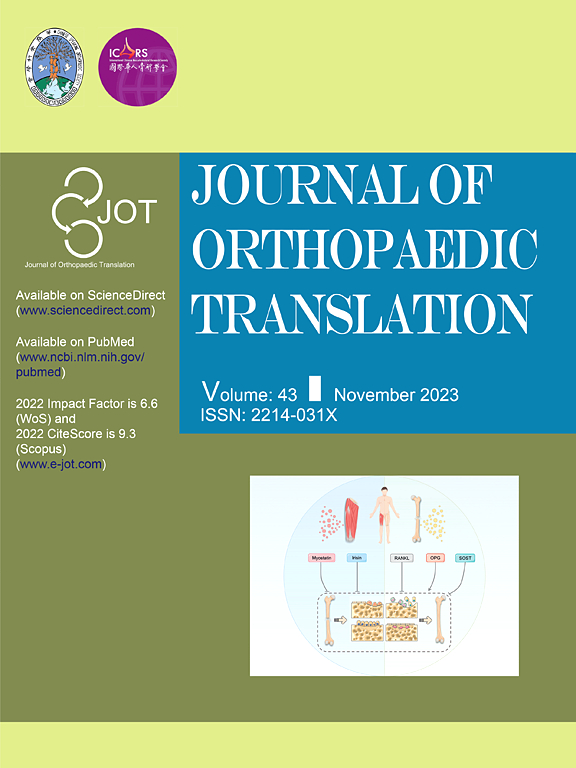1990-2021年中国骨关节炎流行病学趋势及特征
IF 5.9
1区 医学
Q1 ORTHOPEDICS
引用次数: 0
摘要
本研究旨在通过年龄、性别、关节部位、高体重指数(BMI)和社会人口指数(SDI)综合分析1990年至2021年中国骨关节炎(OA)的发病率、患病率和残疾调整生命年(DALYs)。方法从全球疾病负担研究(GBD) 2021中获取数据和方法,评估中国OA负担。该评估是通过估计事件病例数、流行病例数、DALYs和相应的年龄标准化率(ASRs)来进行的。估计的年百分比变化被用来描述一段时间内的趋势。结果到2021年,中国OA发病例数、患病率例数和DALYs分别增加到1165万例、1.5285万例和533万例,呈逐年上升趋势。从1990年到2021年,OA发病率、患病率和DALYs的asr分别上升了13.86%、14.34%和16.23%,其中膝关节OA受影响最大。2021年,女性OA发病率、患病率和DALYs均高于男性,且随年龄增长而增加,发病率在50-54岁达到峰值,患病率和DALYs在55-59岁达到峰值。高BMI导致的OA DALYs迅速增加,高BMI占中国OA总年龄标准化DALYs率的21.64%。从1990年到2021年,ASRs与中国SDI呈显著正相关。结论oa是中国公共卫生面临的重大挑战,疾病负担持续居高不下。迫切需要加强公众对OA相关风险因素的了解,并促进预防策略,以减轻这种疾病的未来负担。中国是全球老年人口最多、OA患病率最高的国家。更新和分析中国OA流行病学数据将为公众、医疗保健专业人员和决策者提供最新、全面和可比较的信息,具有重要的转化潜力。本文章由计算机程序翻译,如有差异,请以英文原文为准。

Epidemiological trends and characteristics of osteoarthritis in China during 1990–2021
Background
This study aimed to comprehensively analyze the incidence, prevalence, and disability-adjusted life years (DALYs) of osteoarthritis (OA) in China from 1990 to 2021 by age, sex, joint sites, high body mass index (BMI) and sociodemographic index (SDI).
Methods
Data and methodologies from the Global Burden of Diseases (GBD) Study 2021 were obtained to evaluate the burden of OA in China. This assessment was conducted by estimating the number of incident cases, prevalent cases, DALYs, and corresponding age-standardized rates (ASRs). The estimated annual percentage change was employed to delineate the trends over time.
Results
In China, the number of OA incidence cases, prevalence cases, and DALYs increased to 11.65 million, 152.85 million and 5.33 million in 2021, respectively, exhibiting a consistent upward trend over the years. The ASRs of OA incidence, prevalence, and DALYs rose 13.86 %, 14.34 %, and 16.23 % from 1990 to 2021, respectively, with knee OA most affected. In 2021, OA incidence, prevalence, and DALYs were higher in women than in men, and increased with age for both sexes, peaking at ages 50–54 for incidence and 55–59 for prevalence and DALYs. DALYs of OA attributed to high BMI increased rapidly, and high BMI contributed to 21.64 % of the total age-standardized DALYs rate of OA in China. Positive correlations were observed between ASRs and China's SDI from 1990 to 2021.
Conclusion
OA constitutes a significant public health challenge in China, with a persistently high disease burden. There is a pressing need to enhance public understanding of the risk factors associated with OA and to promote preventive strategies to mitigate the future burden of this disorder.
The translational potential of this article China has the largest elderly population and the highest prevalence of OA globally. Updating and analyzing epidemiological data of OA in China will offer the public, healthcare professionals, and policymakers the most current, comprehensive, and comparable information, which holds significant translational potential.
求助全文
通过发布文献求助,成功后即可免费获取论文全文。
去求助
来源期刊

Journal of Orthopaedic Translation
Medicine-Orthopedics and Sports Medicine
CiteScore
11.80
自引率
13.60%
发文量
91
审稿时长
29 days
期刊介绍:
The Journal of Orthopaedic Translation (JOT) is the official peer-reviewed, open access journal of the Chinese Speaking Orthopaedic Society (CSOS) and the International Chinese Musculoskeletal Research Society (ICMRS). It is published quarterly, in January, April, July and October, by Elsevier.
 求助内容:
求助内容: 应助结果提醒方式:
应助结果提醒方式:


